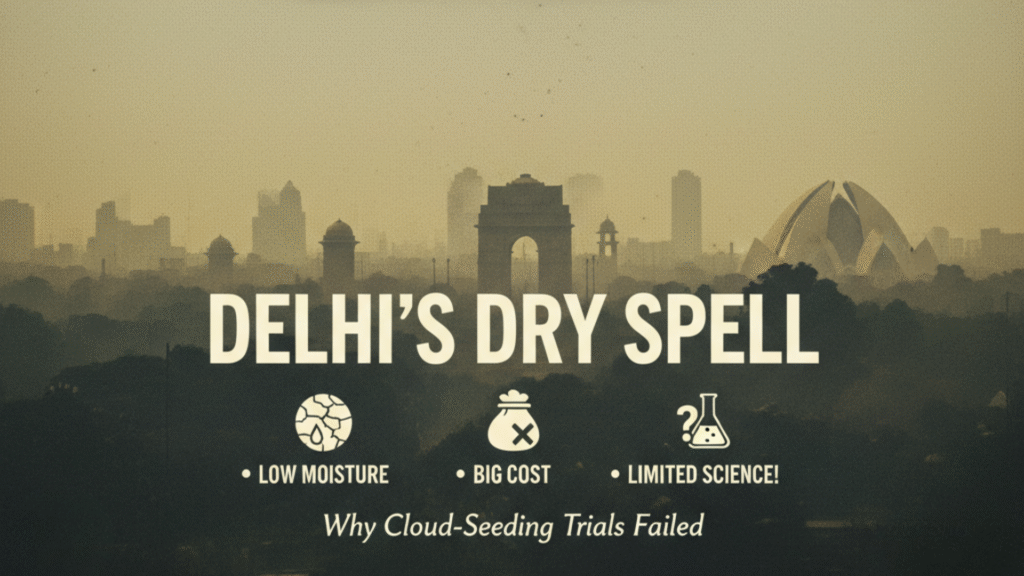
Quick highlights
- Delhi ran cloud-seeding sorties (IIT-Kanpur) to try and wash out winter smog — but they produced no meaningful rain.
- Main technical reason: the atmosphere was too dry — moisture levels under ~20%, while effective seeding usually needs much higher liquid water/ice availability.
- Experts call it temporary, hard to predict, and expensive—critics say emissions controls are a better long-term fix. —moisture
What happened
Delhi’s government hired IIT-Kanpur to run aerial cloud-seeding sorties over parts of the capital in late October 2025 to try to trigger quick showers and reduce hazardous smog. Planes released silver iodide and salt flares across cloud layers, but the operation failed to produce meaningful rainfall in Delhi; only trace amounts were reported in nearby pockets.
Where and when
Trials were flown over northwest Delhi and nearby NCR zones on October 28, 2025, as part of a plan for up to five trials approved earlier by the Delhi cabinet. The work was timed to the post-Diwali pollution spike and winter weather that traps PM2.5.
How cloud seeding is supposed to work
Small particles (often silver iodide or salt) are introduced into clouds to act as ice or condensation nuclei so droplets grow and fall as rain—but only when clouds already carry sufficient moisture and the right temperatures.
Why the trials failed
- Too little moisture. Authorities and IIT-Kanpur said the moisture content in clouds was only about 10–20% (below the practical threshold many scientists use), so there wasn’t enough “fuel” for seeded particles to produce measurable rain. This is the primary, repeatedly stated reason.
- Wrong cloud type/timing. Seeding works only for certain cloud structures and time windows; if you seed the wrong cloud or at the wrong stage, it won’t help. Operational windows in Delhi have been limited and repeatedly postponed.
- Measurement and attribution limits. Even when rain follows seeding, proving the seeding caused it is scientifically difficult—natural variability can produce the same result.
Cost, politics and environmental concerns
The government budgeted ~₹3.2 crore for five trials (≈₹64 lakh per sortie in some reports). Critics say the money buys a short, unpredictable scrub of pollution rather than fixing sources (vehicles, industry, stubble burning). There’s also debate about silver iodide’s long-term environmental impacts: many studies find environmental risks negligible at the tiny concentrations used, but some research flags possible ecological effects if used repeatedly and in large amounts.
What this means
Cloud seeding can sometimes nudge precipitation in the right atmospheric conditions, but it is not a reliable, stand-alone fix for Delhi’s winter smog. Scientists and policy analysts argue the city needs stricter emissions control, crop-burning solutions, transport and construction regulation, and longer-term climate-aware planning rather than one-off weather hacks.
In Conclusion
Cloud seeding failed in Delhi mainly because the atmosphere was too dry and the clouds were unsuitable, not because the method is inherently broken. It remains an experimental, situational tool: sometimes useful, often unpredictable, and never a substitute for cutting pollution at the source.
Stay connected with Unwires.com for more stories, geopolitics, bollywood news, guides, and inspiration. After all, every great journey begins with a spark — and Unwires is that spark. ⚡


